The most endangered animals in the world are species that are at imminent risk of going extinct. Endangered animals have seen their numbers dwindle due to their inability to adapt to growing challenges due to habitat loss and anthropogenic climate change.
View in gallery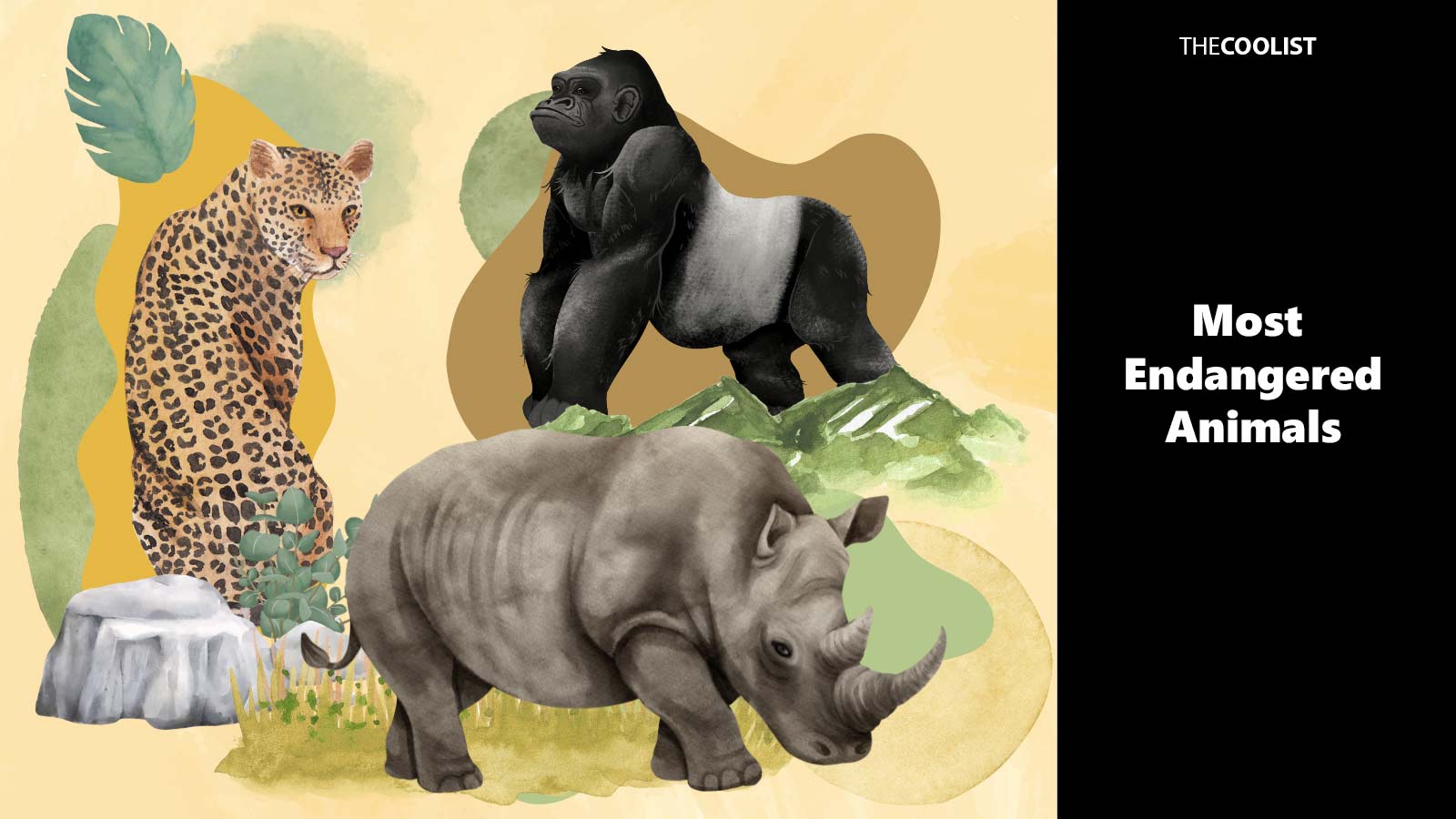
Endangered species are diverse but share several of the same threats and require human intervention to save. These rare animals are at risk of habitat loss, poaching, climate change, and pollution. Government programs are in place to help these animals that are going extinct, but efforts require dedication and international support. For example, the Convention on International Trade in Endangered Species of Wild Fauna and Flora is a multilateral treaty to protect endangered plants and animals from international trade.
Most endangered species depend on human initiatives to survive, but the biodiversity losses may be too great for intervention. For example, the International Union for Conservation of Nature lists over 38,000 plants and animals as threatened or on the brink of extinction. Outlining the plight of these endangered animals is an opportunity to educate and offer support.
The list below showcases the 15 most endangered animals and their main threats.
- Amur leopard: The Amur leopard is a critically endangered leopard subspecies native to southeastern Russia and China, threatened by poaching and habitat loss.
- Mountain gorillas: Mountain gorillas are a critically endangered great ape inhabiting the Virunga Mountains of Central Africa, threatened by habitat loss, poaching, and disease.
- Saola: The saola is a critically endangered rainforest antelope found only in the Annamite Mountains of Vietnam and Laos, threatened by habitat loss and hunting.
- Javan rhinos: The Javan rhino is a critically endangered subspecies confined to a single national park in Indonesia, threatened by poaching and habitat loss.
- African forest elephant: The African forest elephant is a critically endangered rainforest elephant decimated by the ivory trade and habitat loss in Central and West Africa.
- Sumatran orangutan: The Sumatran orangutan is a critically endangered great ape native to the forests of Sumatra, threatened by deforestation and the illegal wildlife trade.
- Yangtze finless porpoise: The Yangtze finless porpoise is a critically endangered freshwater porpoise found only in China’s Yangtze River, threatened by pollution, overfishing, and habitat degradation.
- Kākāpō: The kākāpō is a critically endangered flightless parrot native to New Zealand, threatened by invasive predators and habitat loss.
- Black rhinos: The black rhino is a critically endangered rhino targeted by poachers across eastern and southern Africa for its valuable horn.
- Sunda Island tiger: The Sunda Island tiger is a critically endangered tiger subspecies restricted to the Indonesian island of Sumatra, threatened by poaching and deforestation.
- Tapanuli Orangutan: The Tapanuli orangutan is the rarest and most threatened orangutan, restricted to fragmented forest pockets in northern Sumatra with under 800 left due to a new dam, mining, and hunting.
- Vaquita: The vaquita is the world’s smallest and most endangered porpoise, with fewer than 10 remaining. It is found only in Mexico’s Gulf of California and decimated by illegal gillnet fishing.
- Hawksbill Turtle: The hawksbill turtle is a critically endangered sea turtle with beautiful patterned shells, now numbering 20,000-23,000 globally due to exploitation and loss of coral reef habitats.
- North Atlantic Right Whale: The North Atlantic right whale is one of the world’s most endangered large whales, with fewer than 400 surviving individuals migrating seasonally to feed and breed in areas overlapping dangerously with maritime industries.
- Brown Spider Monkey: The brown spider monkey is a critically endangered frugivorous rainforest monkey largely unique to Colombia and Venezuela that plays a vital forest regeneration role but is declining primarily due to habitat fragmentation.
Below, we examine the 15 most endangered animals, identify the most endangered species, and learn simple things you can do to help save them.
1. Amur leopard
The Amur leopard is an endangered subspecies native to southeastern Russia and China. Fewer than 100 Amur leopards are left due to habitat loss, poaching, and lack of prey. They have physically adapted to the harsh winters of Russia’s Far East, with long, thick fur coats and smaller, nimble builds to survive in their terrain. They are solitary and nocturnal, requiring vast home ranges to ambush deer, hares, and rodents.
View in gallery
Their last refuges are Russia’s Primorsky Krai region and the neighboring Chinese province of Jilin. Governments and non-governmental organizations are collaborating to establish protected habitats, curb poaching, and restore populations of the leopards’ prey.
While these efforts have stabilized numbers, the Amur leopard remains endangered, and its survival hinges on continued habitat protection and community support. The Amur leopard’s fate is an example of the environmental impacts of uncontrolled hunting and deforestation.
2. Mountain gorilla
Mountain gorillas, also known as silverback gorillas, are an endangered great ape surviving in the Virunga Mountains of Central Africa. Adult male mountain gorillas can weigh over 400 lbs. and are equipped with thick fur to handle colder high altitudes. Mountain gorilla groups live in dense mountain vegetation, led by their silverback patriarch, who makes decisions and protects the family unit.
View in gallery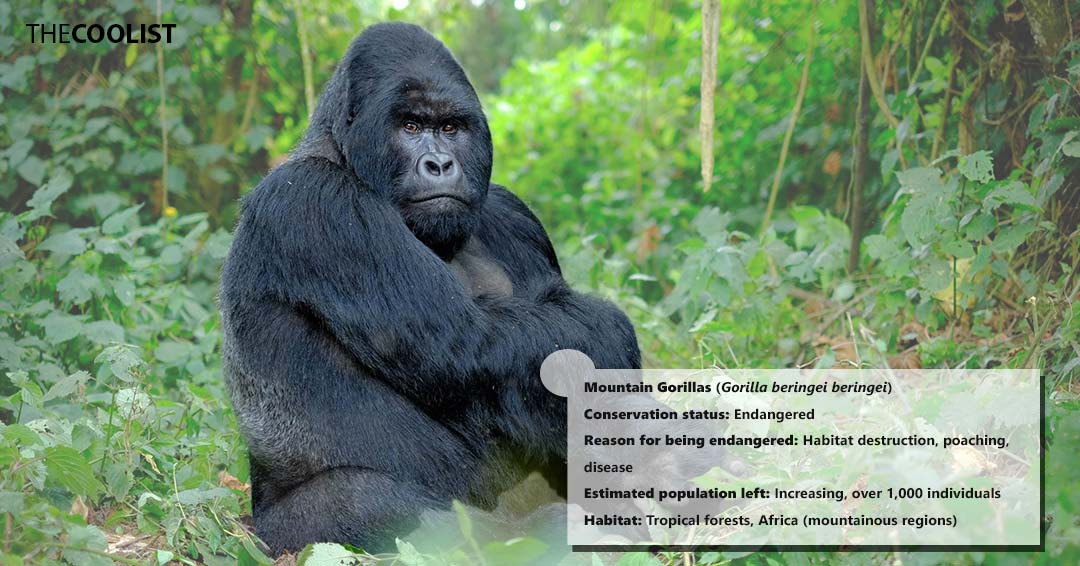
The mountain gorilla population faces severe threats from habitat loss, poaching, human disease transmission, and political instability. The population of mountain gorillas is roughly over 1,000 individuals, and preventing their extinction requires effective action.
Conservation groups, eco-tourism, and government cooperation on anti-poaching patrols and veterinary care have slowly increased mountain gorilla numbers. However, the species remains endangered from encroachment pressures. The mountain gorilla’s plight spotlights the environmental consequences of uncontrolled habitat destruction and disease transmission while showing how collaborative conservation action can reverse the extinction risk trend for fragile species.
3. Saola
The saola, nicknamed the Asian unicorn, is an endangered rainforest antelope in the Annamite Mountains spanning Laos and Vietnam. The Saola was first discovered in 1992 by a joint Russian-Vietnamese team and is considered one of the most remarkable large mammal discoveries of recent decades. Yet today, habitat loss and hunting have driven saola numbers down to an estimated few dozen surviving individuals.
View in gallery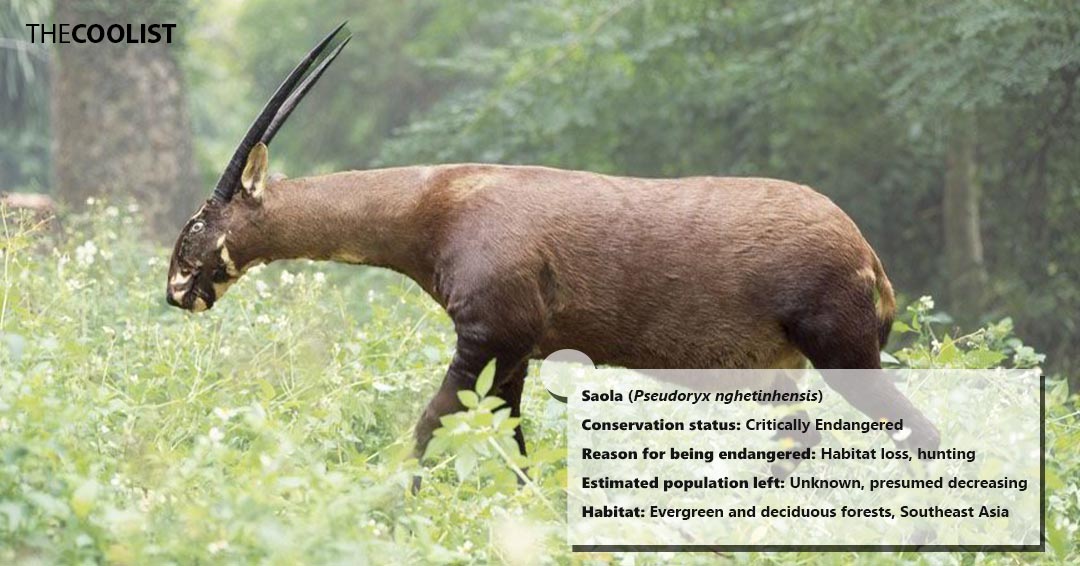
This secretive species possesses distinctive parallel horns that can grow 20 inches long, white facial markings, and adaptations like splayed hooves to traverse dense forest floors. They inhabit lush, evergreen, and deciduous tropical forests marked by river valleys and limestone ridges. While some protected areas exist, logging and infrastructure projects continue to chip away at the saola’s habitat. Meanwhile, indiscriminate wire traps and snares set for other wildlife frequently entrap the docile saola as unintended bycatch.
The saola’s future balances precariously on the edge of ecological change and human forces. Protecting these elusive Asian unicorns will require enhanced habitat protections and reduced regional hunting to preserve this flagship rainforest species and the biodiversity riches of its Annamite home.
4. Javan rhino
The Javan rhino is an endangered subspecies with roughly 72 individuals confined to Indonesia’s Ujung Kulon National Park. Their armor-plated skin and single 10-inch horn are adapted for traversing dense rainforests.
View in gallery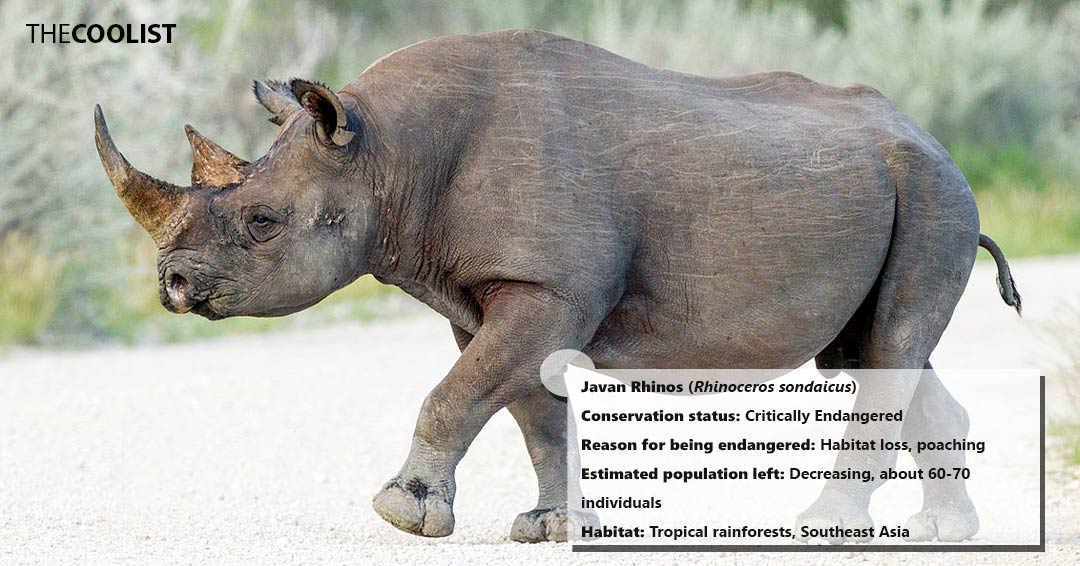
These solitary creatures spend most of their time foraging in tropical forest undergrowth or wallowing in plentiful water sources. Intensive efforts by Indonesian agencies and conservation groups focus on protecting this habitat, enforcing anti-poaching patrols, monitoring rhinos, and maintaining the genetic diversity of this tiny population.
While conservation has stabilized their numbers, Javan rhinos remain under grave threat due to their few concentrated refuges. However, these efforts offer some hope if enhanced protections continue to prevent poaching and preserve habitat. More broadly, the Javan rhino spotlights the consequences of uncontrolled human pressures driving species to extinction.
5. African forest elephant
The African forest elephant is an endangered rainforest elephant targeted by the illegal ivory trade and habitat destruction in Africa’s forests. The African forest elephant is smaller with straighter tusks than savanna elephants, and they play a crucial ecosystem role, dispersing seeds as “mega gardeners” while navigating trailing vegetation in fragmented groups.
View in gallery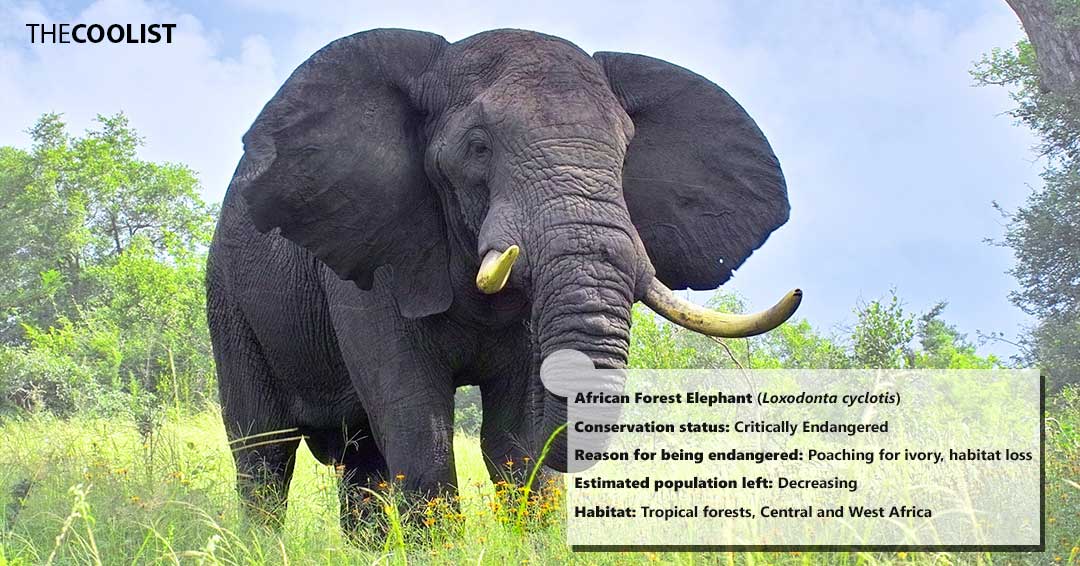
Governments now collaborate on anti-poaching patrols and enforce ivory bans while trying to preserve contiguous habitats. However, major threats remain for this keystone species, which is nearing extinction due primarily to human over-exploitation.
Their uncertain future signifies the disastrous impacts of uncontrolled poaching and deforestation. Preventing the loss of these giants requires amplifying protections and curbing demand to shelter not only a beloved creature but entire ecosystems relying on forest elephants’ persistence.
6. Sumatran orangutan
The Sumatran orangutan is an endangered great ape native to the tropical rainforests of the Indonesian island of Sumatra. There are just over 14,000 surviving Sumatran orangutans, but this arboreal species faces grave threats from deforestation for palm oil and pulpwood plantations and the illegal pet trade.
View in gallery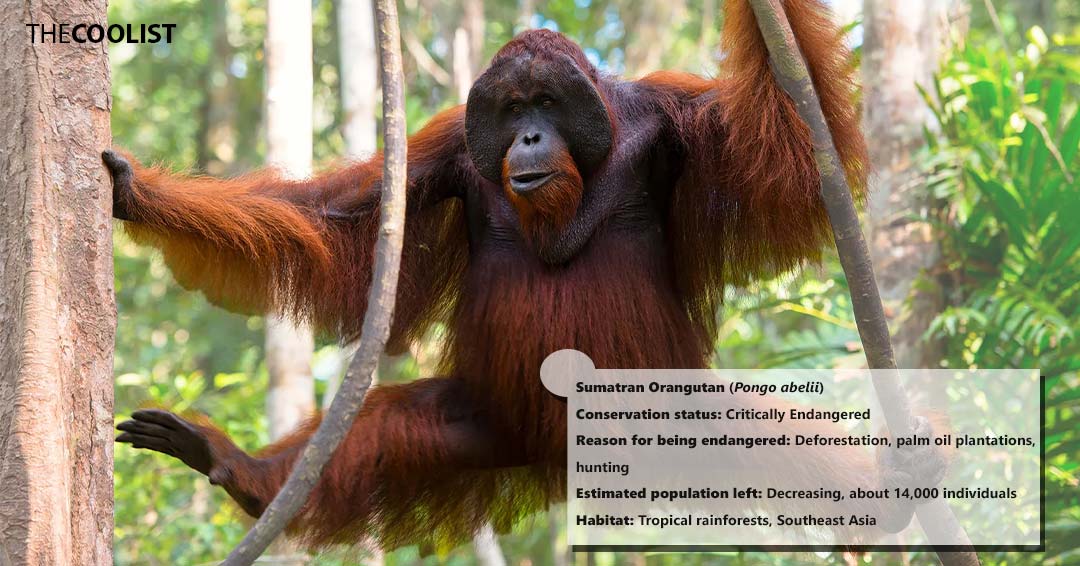
The Sumatran orangutan has adapted to tree living with long arms and loose elbow joints. Their reliance on living among the trees has led to a decline in populations due to the loss of the fruiting forest habitats they depend on. Though intelligent and capable of using basic tools, they have struggled to adapt their behavior as loggers, planters, and poachers continue to erode their jungle homes.
The Indonesian government has partnered with conservation groups to implement rehabilitation programs, anti-poaching patrols, and more sustainable plantation practices. Still, the pace of protective action has not matched the pace of habitat destruction. The precarious future of this great ape serves as a call to action for global cooperation to preserve Indonesia’s fast-vanishing forests and their myriad endangered endemic species.
7. Yangtze finless porpoise
The Yangtze finless porpoise is an endangered freshwater mammal in Asia’s Yangtze River. The Yangtze finless porpoise has a rounded head, lacks a dorsal fin, and grows to an average length of 5-6ft. These porpoises struggle as uncontrolled pollution, overfishing, and relentless development impact their limited habitat.
View in gallery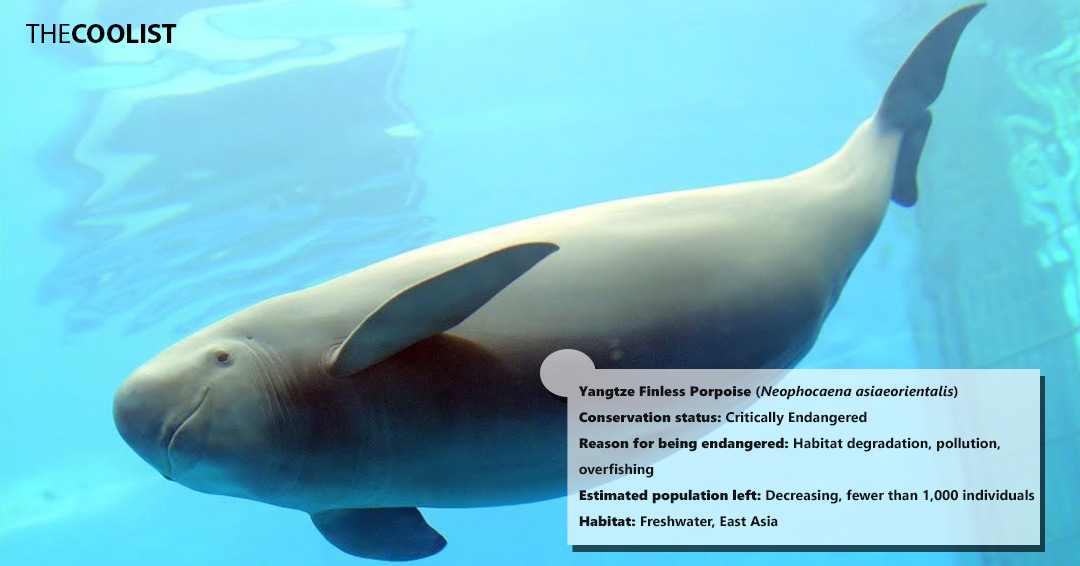
While Chinese authorities have funded research, enforced fishing regulations in protected river reserves, and aimed to improve water quality, these shy, playful porpoises face ongoing threats from habitat fragmentation. Their uncertain future signals the environmental crisis facing the entire Yangtze system.
Protecting this species from extinction requires sustained conservation efforts to restore habitats, curb pollution, and enforce bans on practices impeding the river’s ecological balance. They will be the first cetaceans extinguished by human impacts if they disappear, which underscores society’s failure to prevent once-thriving ecosystems from declining dangerously.
8. Kākāpō
The kākāpō is a critically endangered flightless parrot originating in historically predator-free New Zealand. Kākāpō are large, nocturnal birds with striking camouflaged plumage that struggle against introduced species like stoats, feral cats, and rats. These threats decreased their numbers to 250 known surviving individuals at three predator-cleared sanctuaries.
View in gallery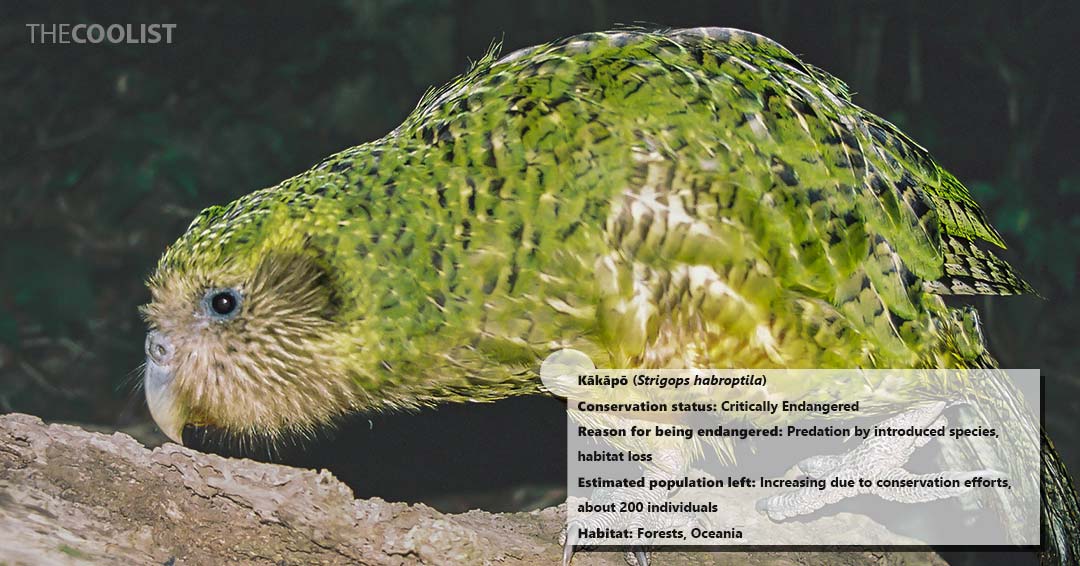
Concentrated conservation efforts by New Zealand’s Department of Conservation focus on predator control programs, population and genetic management, and breeding habitat restoration. This has slowly increased the wild numbers of these amiable, ground-dwelling herbivores with their unique booming mating calls. However, their future remains imperiled without expanding disease-free refuges for this world’s only flightless parrot.
The kākāpō’s plight highlights the disastrous impacts of invasive species on New Zealand’s endemic bird diversity. Protecting such ecological oddities relies on unrelenting nationwide campaigns to deter introduced predators and restore fragmented local habitats before unique biodiversity vanishes from the global stage.
9. Black rhino
The black rhino is a critically endangered African rhino that roams the savannas and woodlands. Black rhinos are solitary titans targeted by poachers for their horns despite conservation successes increasing numbers to around 5,500.
View in gallery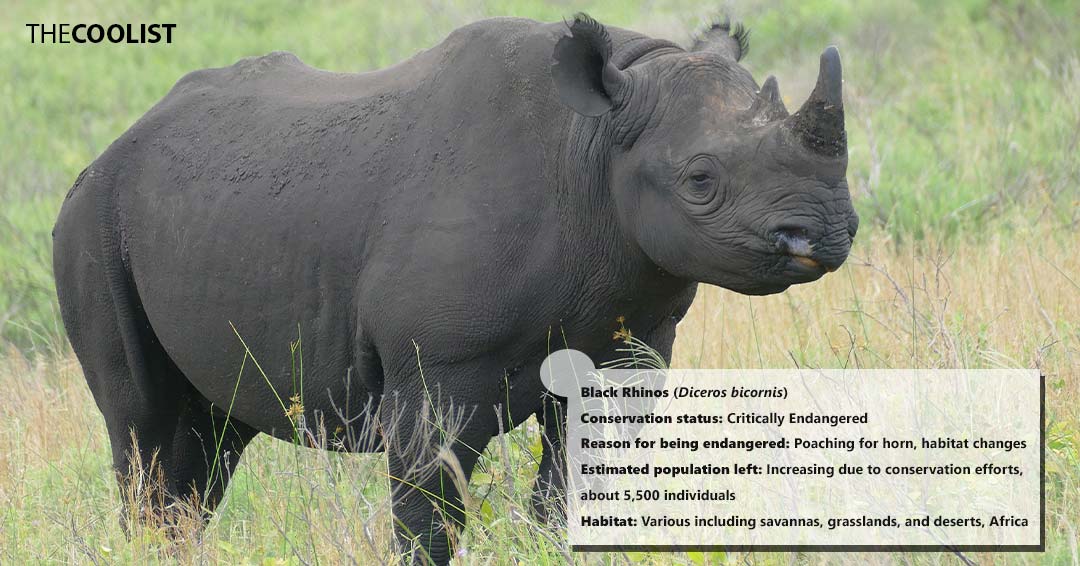
Multifaceted efforts by conservation groups and African authorities focus on anti-poaching patrols, habitat protection, and community stewardship to deter trafficking and stabilize local black rhino populations. While still endangered, cautious optimism exists as some groups stabilize under increased safeguards.
However, the black rhino’s uncertain future highlights wildlife conservation challenges. Only sustained global initiatives to combat illegal hunting alongside strengthened local habitat protections can ensure the iconic black rhino continues roaming wild African landscapes for generations rather than languishing solely in zoos as a relic of humankind’s callousness towards the natural world.
10. Sunda Island tiger
The Sunda Island tiger, also known as the Sumatran tiger, is a critically endangered subspecies restricted to the tropical forests of Indonesia’s Sumatra. Sunda Island Tigers have adapted with smaller builds and camouflaged coats to thrive in dense rainforests. Despite their camouflage, fewer than 400 likely remain due to poaching and rampant habitat loss for palm oil and pulpwood.
View in gallery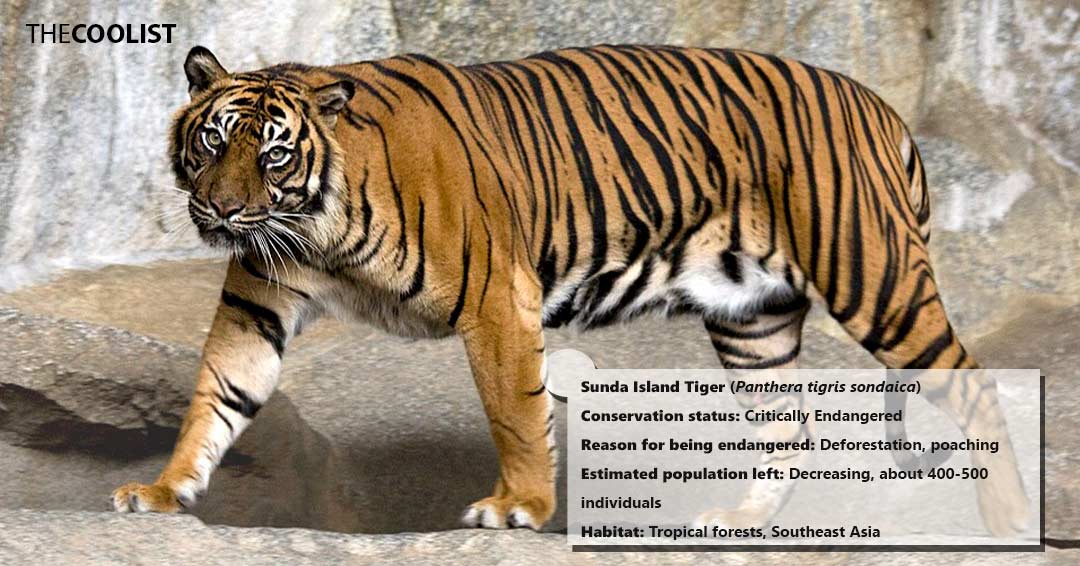
As apex predators of their ecosystems, these solitary tigers keep wild herds in balance when roaming undisturbed. However, palm oil encroachment and poacher snares for skins, bones, and body parts have severely constrained surviving tiger terrain. While the Indonesian government partners with conservation groups on ranger patrols and protected forests, the beleaguered Sunda Island tiger’s future remains uncertain.
Their symbolism as the last island tigers spotlights the consequences of unchecked habitat destruction and trafficking. Preventing their extinction requires fortifying and connecting wild tiger refuges through stronger environmental policies and enforcement to deter human influence that is driving the species’ decline.
11. Tapanuli orangutan
The Tapanuli orangutan is a tree-bound primate in Indonesia’s patchwork Batang Toru rainforests, numbering less than 800 individuals. Tapanuli orangutans are distinguished by unruly fur and unique vocalizations among great apes. However, their habitat of fruiting fig forests has fallen to hydroelectric dams, mining, and agriculture.
View in gallery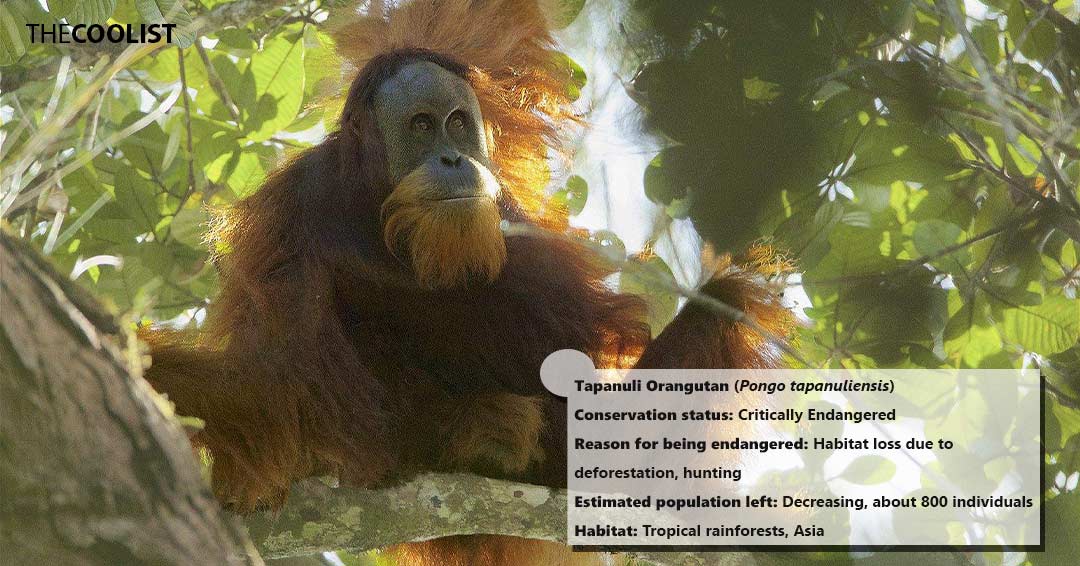
The Tapanuli is an example of a rare species stranded by human interference as they cannot adapt to the chainsaws and backhoes encroaching on their home. While conservationists labor to connect fragmented groups across protected forest corridors, time is running out for the world’s rarest orangutan as legal safeguards lag behind habitat loss.
The Tapanuli’s predicament is a rallying cry for balanced development where wildlife, environmental health, and human needs are met sustainably. Their conservation depends on effective and immediate action by Indonesia to combat the damage from development.
12. Vaquita
The vaquita is a porpoise found only in Mexico’s Upper Gulf of California and is the world’s smallest and most endangered cetacean. Fewer than 10 vaquitas likely remain after years of falling victim to illegal gillnet fishing for the equally endangered totoaba fish.
View in gallery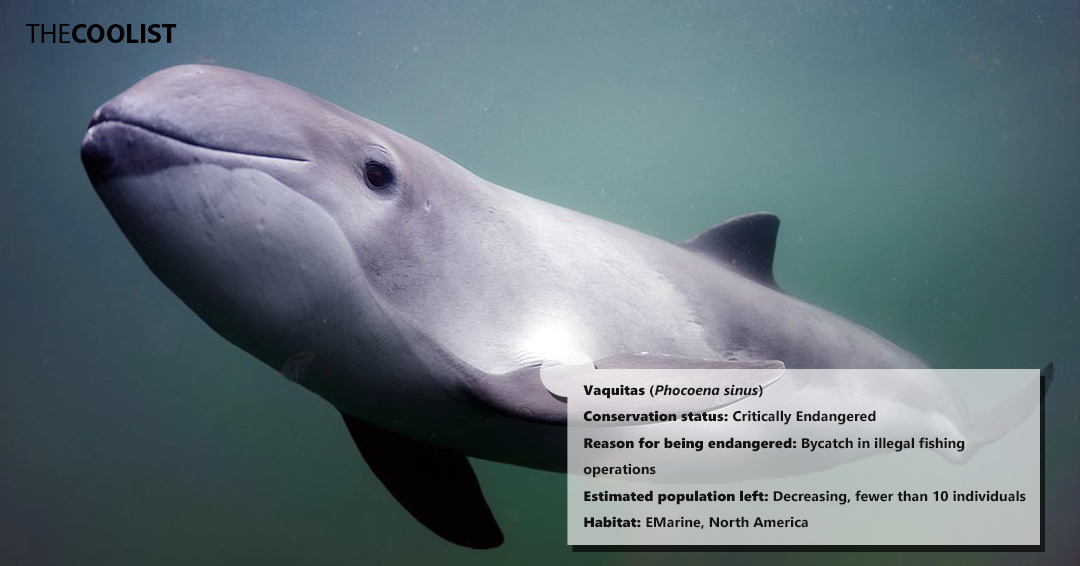
Vaquitas face localized extinction in a delicate region burdened by unsustainable fishing practices because they are bycatch in the illegal totoaba fish bladder trade. Despite bans, net removal, and failed breeding attempts, the species’ chances for recovery remain uncertain without eliminating the demand for trafficked swim bladders.
The vaquita’s impending extinction emphasizes how uncontrolled wildlife trade decimates localized species, especially those with restricted habitats like endemic porpoises. Their critical status is an urgent call to action to enact swifter protections before permanently losing them and their habitat. Saving the vanishing vaquita now depends on immediate enforcement of gillnet bans and alternative economic opportunities for local communities.
13. Hawksbill turtle
The Hawksbill turtle is a critically endangered sea turtle recognized by its colorful, patterned shell and distinctive narrow beak. These reptiles circle coral reefs across the tropics and play a vital ecosystem role by feeding on reef-smothering sponges. Due to habitat loss and pollution, there are now only 20,000 to 23,000 estimated individuals.
View in gallery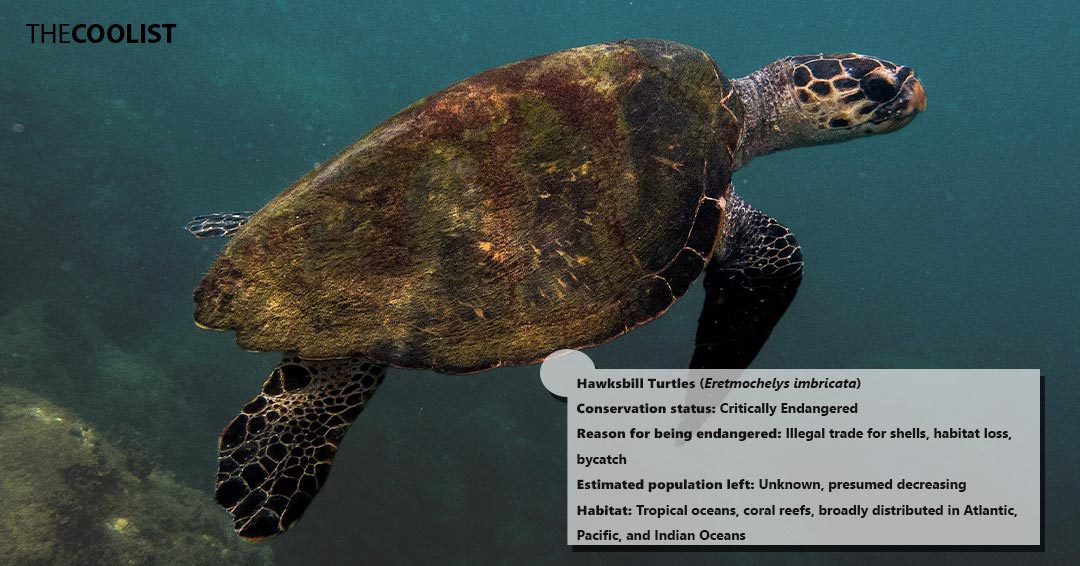
These long-distance migrants travel far between nesting beaches and feeding areas, which increases the likelihood they encounter threats from trade seeking their shell’s decorative appeal. Additionally, they suffer from warming and rising seas inundating nests along tropical coastlines. While governments and conservation groups now protect habitats and promote alternative turtle products, long-term recovery remains challenged by the pressure from industry and climate change.
The hawksbill epitomizes the trials facing marine life, especially migratory species dependent on threatened coastal and underwater areas. To ensure future generations can enjoy the hawksbill’s spectacular diving displays requires amplifying environmental protections across jurisdictional boundaries from nesting beaches to distant feeding grounds.
14. North Atlantic right whale
The North Atlantic right whale is one of the world’s most endangered large whales, with fewer than 400 surviving. These slow-moving, 70-ton whales migrate yearly from the Gulf of Maine to southeastern calving grounds.
View in gallery
However, their migration routes and shallow feeding areas overlap with shipping lanes and fishing grounds. The routes leave the whales at risk of entanglement and vessel strikes, which reduces their population. While monitoring and habitat protections aim to reduce mortality events, their dangerously low populations and slow reproductive rates challenge recovery efforts.
These broad-backed leviathans highlight the overlooked risks facing less visible but equally monumental marine life from human impacts on regional food chains and migratory patterns. Saving North Atlantic right whales requires international cooperation to balance maritime industries with the needs of species that coastal communities have relied upon for centuries.
15. Brown spider monkey
The brown spider monkey is a critically endangered species of New World primate native to the tropical rainforests of Colombia and Venezuela. Recognized by lanky limbs and prehensile tails, these large monkeys form complex social groupings, yet now number few due to habitat loss and bushmeat hunting.
View in gallery
They are primarily frugivorous seed dispersers and are crucial in forest regeneration. However, they require vast contiguous forest homes, which agricultural and logging interests continue to fragment. While local groups work to expand protected areas, active poaching and clearing for plantation crops hamper population recovery.
Conservation efforts include habitat protection, reforestation programs, and efforts to curb hunting. Organizations are working with local communities and governments to protect existing forest cover and establish new protected areas. The decline of agile monkeys like the brown spider monkey shows the importance of saving fragile forest systems before cascading biodiversity losses unravel the delicate balance.
What is the most endangered animal?
The vaquita is a small porpoise found in the Gulf of California and is considered the most endangered animal in the world. The vaquita has an estimated population of fewer than 10 individuals due to bycatch in illegal gillnets for fishing another endangered species, the totoaba fish. The totoaba’s swim bladder is highly valued in Traditional Chinese Medicine, which has led to rampant and unsustainable fishing practices in the vaquita’s habitat.
The vaquita’s situation exemplifies how the illegal wildlife trade impacts the environment by highlighting the unintended consequences of fishing practices and the challenges of protecting species with limited habitats. Conservation efforts include enforcing fishing bans, removing gillnets, and raising awareness about their situation. However, the extremely low population numbers significantly challenge recovery efforts.
How important are endangered animals in the ecosystem?
Endangered animals are invaluable in the ecosystem due to their contributions to biodiversity and genetic diversity. They play crucial roles in pollination and seed dispersal, essential for maintaining diverse plant communities and supporting agricultural systems.
Losing endangered species diminishes an ecosystem’s resilience by reducing the genetic variety necessary for adaptation or recovery from threats like climate change. For example, Tasmanian devils are an endangered carnivorous marsupial native to Tasmania that are threatened by the development of Devil Facial Tumor Disease. Tasmanian devils are excellent hunters, and farmers have begun to value them for keeping rodent populations down; however, their endangerment will impact the sensitive balance.
The absence of these animals damages ecosystem services such as water filtration, air purification, and climate regulation, which are fundamental for human well-being. Preserving them maintains wildlife and quality of life for society over the long term. By prioritizing the conservation of the most vulnerable organisms, we safeguard ecological riches and resources that humanity depends on for prosperity and survival.
What is the most common reason why animals become endangered?
The most common reasons animals become endangered are typically human-induced due to various activities that disrupt and destroy natural habitats. The leading culprit is habitat loss in the form of urbanization, agriculture, and extractive industries fragmenting or destroying natural environments animals need to survive. Moreover, commercial overfishing and bushmeat hunting compound the problem by removing wildlife faster than populations can reproduce.
Humans are the main contributor to pollution, which introduces substances alien to local ecosystems with disastrous effects. Invasive competitors and diseases transported through global trade outcompete native species already struggling in degraded habitats. Climate change exacerbates these threats by altering habitats and disrupting seasonal rhythms species depend on. Furthermore, as human economies expand, animals must contend with threats ranging from infrastructure blocking migration routes to pesticides poisoning food sources.
While natural factors like genetic bottlenecks occur, human encroachment and indifference drive the modern mass extinction crisis. Solving the reasons behind endangerment and extinction requires curbing the key dangers to wildlife from human economic activities.
What simple things can people do to help save endangered animals?
The list below highlights five simple things you can do to help save endangered animals.
- Support conservation organizations: Donating to or volunteering with organizations dedicated to wildlife conservation can make a significant difference. These groups work on various fronts, from habitat preservation to anti-poaching efforts, and public support is vital for their success.
- Raise awareness: Raising awareness about the plight of endangered species involves sharing information on social media, engaging in community education programs, or discussing wildlife conservation with friends and family.
- Choose sustainable products: Choosing products that are sustainably sourced helps reduce the demand for resources that come from habitats of endangered species. This includes avoiding products from endangered animals or plants and choosing those with certifications like Rainforest Alliance or Marine Stewardship Council.
- Responsible wildlife viewing: Opt for responsible wildlife viewing when engaging in wildlife tourism by choosing responsible tour operators and adhering to guidelines that minimize disturbance to animals and their habitats.
- Respect habitat: Respecting the natural habitats of endangered species can be as simple as practicing Leave No Trace principles during outdoor activities, supporting land conservation efforts, and engaging in local habitat restoration projects.
Do governments launch programs to help save endangered animals?
Yes, governments worldwide launch programs that help save endangered animals, guided by national legislation and international agreements. A prominent example is the Endangered Species Act (ESA) in the United States, which was established in 1973. The ESA focuses on conserving species at risk of extinction, along with the ecosystems they depend on. It prohibits unauthorized take or trade while funding protection programs.
Similarly, the Convention on International Trade in Endangered Species of Wild Fauna and Flora (CITES) was initiated in 1975 and regulates cross-border commerce. This treaty, involving 184 countries, regulates the international trade of over 38,000 species of plants and animals. The ESA and CITES showcase national and global commitments to safeguard biodiversity via impactful policymaking. They demonstrate how governments work proactively through research-based species plans and enforceable regulations. Conservation is complex, but these accords offer frameworks for ongoing collaboration in managing shared ecological resources.
How do endangered species affect other animals in the environment?
Endangered species are vital to a healthy ecosystem’s food web and support biodiversity. When endangered plants or animals decline or disappear, the effects ripple across the habitats to affect other animals and human industry.
Losing top predators can cause prey species to spike and collapse from lack of food and shelter. For example, the grey wolf in Yellowstone National Park is a crucial element in its thriving ecosystem. The wolves prey on elk, who overeat the flora of Yellowstone, which damages the habitat for beavers. The beavers in Yellowstone contribute to an abundance of slow-moving streams that house the willow trees they use to build dams. The wolves, elk, beavers, and willows are vital for the ecosystem’s flourishing.
Strong ecosystems depend on balance, where each organism contributes. When humanity puts rare species further at risk, we undermine ecosystem services and resources that societies and economies require to function and prosper. Protecting animals in the environment and especially endangered species preserves not just those individual plants or animals but the health and resilience of habitats we all share.
Is it possible to keep endangered animals as pets?
No, keeping endangered animals as pets isn’t possible because of international and national regulations, such as CITES. These laws aim to protect endangered species and their natural habitats.
Caring for endangered species requires specialized knowledge and facilities that are nearly impossible for an individual pet owner to replicate. For this reason, conservation efforts are better supported by preserving natural habitats, combating poaching and illegal trade, and allowing endangered species to remain in the wild or specialized wildlife facilities. Additionally, removing them from native habitats disrupts wild populations and ecological balance.
While the desire to care for rare and fascinating creatures is understandable, keeping endangered species as personal pets causes more harm than good. Supporting reputable zoos, sanctuaries, and conservation groups offers ethical alternatives to connect with and protect threatened wildlife.

